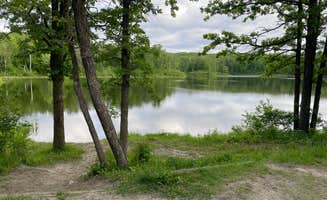Paul Bunyan State Forest offers rustic camping near Midway, Minnesota with sites scattered across more than 105,000 acres of mixed hardwood and pine forest. The forest sits on glacial moraine terrain with elevation changes between 1,300 and 1,500 feet, creating a landscape dotted with small lakes and wetlands. Winter access to many sites is restricted due to seasonal road closures, typically from November through April.
What to do
Fishing opportunities: Little Gulch Lake offers a secluded fishing experience with smallmouth bass, which are uncommon in the region. According to one visitor at Little Gulch Lake canoe campsite, "The lakes are clear and pristine, and far from crowds although within an easy drive of Akely, Bemidji, Itasca and Park Rapids."
Wildlife observation: Early mornings provide the best opportunities to see deer, beaver, and various bird species. Visitors to Waboose Lake report "scenic view with the sounds of loons and frogs in the background," making it ideal for nature photography and birdwatching.
Paddling routes: The Little Gulch Lakes chain offers excellent non-motorized boating options. One camper noted it's "a great destination for canoeing or kayaking from lake to lake, all along a unique glacial moraine with deep quiet forests, plenty of wildlife, and crystal clear water in narrow but very deep glacial lakes."
What campers like
Solitude and quiet: The dispersed camping areas see minimal traffic, especially on weekdays. A regular visitor to Waboose Lake mentions, "I have camped there twice and have never come across another hiker," highlighting the privacy these sites offer.
Accessibility with remoteness: Halverson Trail Camp provides backcountry feel without difficult access. As one camper notes, it's "about a 10-15 min drive from main road and there are more campsites to find further in," making it accessible for those seeking isolation without extreme off-roading.
Diverse camping options: Depending on preference, visitors can choose drive-in, hike-in, or boat-in sites. The Little Gulch campsite "could accommodate several small groups" and has "many good tent sites, and a picnic area, all on a lovely peninsula on the north side of the lake."
What you should know
Limited cell service: Coverage is spotty throughout the forest. One camper at Little Gulch Lake reported, "I have verizon and there is no cell service at this sight. There were some bars closer to where you drive in but still nothing great."
Water considerations: Drinking water is not provided at most sites. At Little Gulch Lake, "though the water is basically clear and clean you should either bring your own water jug or plan to boil or filter the nearby lake water as there is a lot of beaver activity in the area."
Insect activity: Prepare for seasonal bugs, especially in early summer. A visitor noted some sites are "extremely buggy" with potential for ground nests near established camping areas.
Tips for camping with families
Short hiking options: Waboose Lake offers child-friendly access with "a fairly short hike" to reach the campsite. The loop trail around the lake provides opportunities for young explorers without overexertion.
Site selection timing: Arrive early to secure preferred spots, as most dispersed sites operate on first-come, first-served basis. The limited space at some locations means "there's only room for one group to camp here so if you get there early it's pretty secluded."
Trail navigation: When exploring near Waboose Lake, a camper advises, "follow the WHITE blazes to stay on the Waboose Loop. Occasionally you will see blue and white blazes on the same tree. That's because the NCT is marked in blue, and again, the two trails join together for a bit."
Tips from RVers
Access limitations: Most primitive camping sites in Paul Bunyan State Forest have restricted RV access. While Little Gulch campsite "would have room for a small trailer or two to drive in," it offers "no hook ups of any kind as this is a backcountry location."
Seasonal road conditions: Forest service roads can become impassable for larger vehicles after heavy rain. Several campers note these roads are "closed in winter and spring," requiring advance planning for RV camping seasons.



